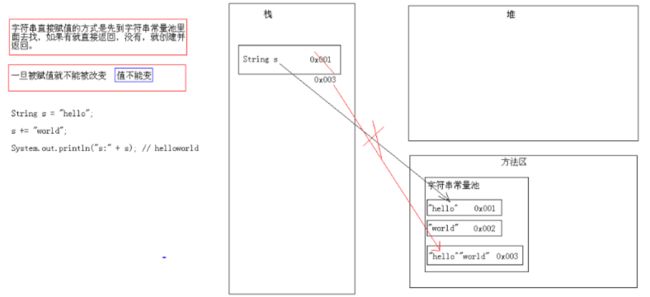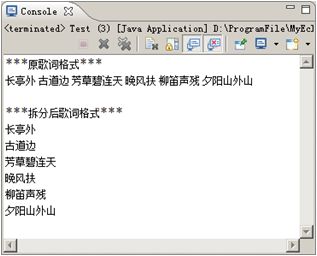配套视频教程
String类位于java.lang包中,具有丰富的方法
字符串的初始化方法
/*
* 字符串:就是由多个字符组成的一串数据。也可以看成是一个字符数组。
* 通过查看API,我们可以知道
* A:字符串字面值"abc"也可以看成是一个字符串对象。
* B:字符串是常量,一旦被赋值,就不能被改变。
*
* 初始化方法:
* public String():
* public String(String original):把字符串常量值转成字符串
*
* 字符串的方法:
* public int length():返回此字符串的长度。
*/
public class StringDemo {
public static void main(String[] args) {
// public String():
String s1 = new String();
System.out.println("s1:" + s1);
System.out.println("s1.length():" + s1.length());
System.out.println("--------------------------");
//s1:
//s1.length():0
//public String(String original):把字符串常量值转成字符串
String s6 = new String("abcde");
System.out.println("s6:" + s6);
System.out.println("s6.length():" + s6.length());
System.out.println("--------------------------");
//字符串字面值"abc"也可以看成是一个字符串对象。
String s7 = "abcde";
System.out.println("s7:"+s7);
System.out.println("s7.length():"+s7.length());
}
}字符串的特点:一旦被赋值,就不能改变。
但是引用可以改变.
public class StringDemo {
public static void main(String[] args) {
String s = "hello";
s += "world";
System.out.println("s:" + s); // helloworld
}
}String s = new String(“hello”)和 String s = “hello”;的区别?
String字面值对象和构造方法创建对象的区别
/*
* String s = new String(“hello”)和String s = “hello”;的区别?
* 有。前者会创建2个对象,后者创建1个对象。
*
* ==:比较引用类型比较的是地址值是否相同
* equals:比较引用类型默认也是比较地址值是否相同,而String类重写了equals()方法,比较的是内容是否相同。
*/
public class StringDemo2 {
public static void main(String[] args) {
String s1 = new String("hello");
String s2 = "hello";
System.out.println(s1 == s2);// false
System.out.println(s1.equals(s2));// true
}
} String s5 = "hello";
String s6 = "hello";
System.out.println(s5 == s6);// 字符串字面量,直接从内存找,所以true
System.out.println(s5.equals(s6));// trueString类的判断功能:
/*
* String类的判断功能:
* boolean equals(Object obj):比较字符串的内容是否相同,区分大小写
* boolean equalsIgnoreCase(String str):比较字符串的内容是否相同,忽略大小写
* boolean contains(String str):判断大字符串中是否包含小字符串
* boolean startsWith(String str):判断字符串是否以某个指定的字符串开头
* boolean endsWith(String str):判断字符串是否以某个指定的字符串结尾
* boolean isEmpty():判断字符串是否为空。
*
* 注意:
* 字符串内容为空和字符串对象为空。
* String s = "";//对象存在,所以可以调方法
* String s = null;//对象不存在,不能调方法
*/
public class StringDemo {
public static void main(String[] args) {
// 创建字符串对象
String s1 = "helloworld";
String s2 = "helloworld";
String s3 = "HelloWorld";
// boolean equals(Object obj):比较字符串的内容是否相同,区分大小写
System.out.println("equals:" + s1.equals(s2));
System.out.println("equals:" + s1.equals(s3));
System.out.println("-----------------------");
// boolean equalsIgnoreCase(String str):比较字符串的内容是否相同,忽略大小写
System.out.println("equals:" + s1.equalsIgnoreCase(s2));
System.out.println("equals:" + s1.equalsIgnoreCase(s3));
System.out.println("-----------------------");
// boolean contains(String str):判断大字符串中是否包含小字符串
System.out.println("contains:" + s1.contains("hello"));
System.out.println("contains:" + s1.contains("hw"));
System.out.println("-----------------------");
// boolean startsWith(String str):判断字符串是否以某个指定的字符串开头
System.out.println("startsWith:" + s1.startsWith("h"));
System.out.println("startsWith:" + s1.startsWith("hello"));
System.out.println("startsWith:" + s1.startsWith("world"));
System.out.println("-----------------------");
// 练习:boolean endsWith(String str):判断字符串是否以某个指定的字符串结尾这个自己玩
// boolean isEmpty():判断字符串是否为空。
System.out.println("isEmpty:" + s1.isEmpty());
String s4 = "";
String s5 = null;
System.out.println("isEmpty:" + s4.isEmpty());
// NullPointerException
// s5对象都不存在,所以不能调用方法,空指针异常
// System.out.println("isEmpty:" + s5.isEmpty());
}
}String类的获取功能
/*
* String类的获取功能
* int length():获取字符串的长度。
* char charAt(int index):获取指定索引位置的字符
* int indexOf(int ch):返回指定字符在此字符串中第一次出现处的索引。
* 为什么这里是int类型,而不是char类型?
* 原因是:'a'和97其实都可以代表'a'。如果里面写char,就不能写数字97了
* int indexOf(String str):返回指定字符串在此字符串中第一次出现处的索引。
* int indexOf(int ch,int fromIndex):返回指定字符在此字符串中从指定位置后第一次出现处的索引。
* int indexOf(String str,int fromIndex):返回指定字符串在此字符串中从指定位置后第一次出现处的索引。
* String substring(int start):从指定位置开始截取字符串,默认到末尾。
* String substring(int start,int end):从指定位置开始到指定位置结束截取字符串。
*/
public class StringDemo {
public static void main(String[] args) {
// 定义一个字符串对象
String s = "helloworld";
// int length():获取字符串的长度。
System.out.println("s.length:" + s.length());//10
System.out.println("----------------------");
// char charAt(int index):获取指定索引位置的字符
System.out.println("charAt:" + s.charAt(7));//
System.out.println("----------------------");
// int indexOf(int ch):返回指定字符在此字符串中第一次出现处的索引。
System.out.println("indexOf:" + s.indexOf('l'));
System.out.println("----------------------");
// int indexOf(String str):返回指定字符串在此字符串中第一次出现处的索引。
System.out.println("indexOf:" + s.indexOf("owo"));
System.out.println("----------------------");
// int indexOf(int ch,int fromIndex):返回指定字符在此字符串中从指定位置后第一次出现处的索引。
System.out.println("indexOf:" + s.indexOf('l', 4));
System.out.println("indexOf:" + s.indexOf('k', 4)); // -1
System.out.println("indexOf:" + s.indexOf('l', 40)); // -1
System.out.println("----------------------");
// 自己练习:int indexOf(String str,int
// fromIndex):返回指定字符串在此字符串中从指定位置后第一次出现处的索引。
// String substring(int start):从指定位置开始截取字符串,默认到末尾。包含start这个索引
System.out.println("substring:" + s.substring(5));
System.out.println("substring:" + s.substring(0));
System.out.println("----------------------");
// String substring(int start,intend):从指定位置开始到指定位置结束截取字符串。
//包括start索引但是不包end索引
System.out.println("substring:" + s.substring(3, 8));
System.out.println("substring:" + s.substring(0, s.length()));
}
}根据身份证号解析出生日
字符串遍历:
/*
* 需求:遍历获取字符串中的每一个字符
*
* 分析:
* A:如何能够拿到每一个字符呢?
* char charAt(int index)
* B:我怎么知道字符到底有多少个呢?
* int length()
*/
public class StringTest {
public static void main(String[] args) {
// 定义字符串
String s = "helloworld";
for (int x = 0; x < s.length(); x++) {
System.out.println(s.charAt(x));
}
}
}统计大写字母,小写字母,数字在字符串中的个数
/*
* 需求:统计一个字符串中大写字母字符,小写字母字符,数字字符出现的次数。(不考虑其他字符)
* 举例:
* "Hello123World"
* 结果:
* 大写字符:2个
* 小写字符:8个
* 数字字符:3个
*
* 分析:
* 前提:字符串要存在
* A:定义三个统计变量
* bigCount=0
* smallCount=0
* numberCount=0
* B:遍历字符串,得到每一个字符。
* length()和charAt()结合
* C:判断该字符到底是属于那种类型的
* 大:bigCount++
* 小:smallCount++
* 数字:numberCount++
*
* 这道题目的难点就是如何判断某个字符是大的,还是小的,还是数字的。
* ASCII码表:
* 0 48
* A 65
* a 97
* 虽然,我们按照数字的这种比较是可以的,但是想多了,有比这还简单的
* char ch = s.charAt(x);
*
* if(ch>='0' && ch<='9') numberCount++
* if(ch>='a' && ch<='z') smallCount++
* if(ch>='A' && ch<='Z') bigCount++
* D:输出结果。
*
* 练习:把给定字符串的方式,改进为键盘录入字符串的方式。
*/
public class StringTest2 {
public static void main(String[] args) {
//定义一个字符串
String s = "Hello123World";
//定义三个统计变量
int bigCount = 0;
int smallCount = 0;
int numberCount = 0;
//遍历字符串,得到每一个字符。
for(int x=0; x='a' && ch<='z'){
smallCount++;
}else if(ch>='A' && ch<='Z'){
bigCount++;
}else if(ch>='0' && ch<='9'){
numberCount++;
}
}
//输出结果。
System.out.println("大写字母"+bigCount+"个");
System.out.println("小写字母"+smallCount+"个");
System.out.println("数字"+numberCount+"个");
}
} String的转换功能:
/*
* String的转换功能:
* byte[] getBytes():把字符串转换为字节数组。
* char[] toCharArray():把字符串转换为字符数组。
* static String valueOf(char[] chs):把字符数组转成字符串。
* static String valueOf(int i):把int类型的数据转成字符串。
* 注意:String类的valueOf方法可以把任意类型的数据转成字符串。
* String toLowerCase():把字符串转成小写。
* String toUpperCase():把字符串转成大写。
* String concat(String str):把字符串拼接。
*/
public class StringDemo {
public static void main(String[] args) {
// 定义一个字符串对象
String s = "JavaSE";
// byte[] getBytes():把字符串转换为字节数组。
byte[] bys = s.getBytes();
for (int x = 0; x < bys.length; x++) {
System.out.println(bys[x]);
}
System.out.println("----------------");
// char[] toCharArray():把字符串转换为字符数组。
char[] chs = s.toCharArray();
for (int x = 0; x < chs.length; x++) {
System.out.println(chs[x]);
}
System.out.println("----------------");
// static String valueOf(char[] chs):把字符数组转成字符串。
String ss = String.valueOf(chs);
System.out.println(ss);
System.out.println("----------------");
// static String valueOf(int i):把int类型的数据转成字符串。
int i = 100;
String sss = String.valueOf(i);
System.out.println(sss);
System.out.println("----------------");
// String toLowerCase():把字符串转成小写。
System.out.println("toLowerCase:" + s.toLowerCase());
System.out.println("s:" + s);
// System.out.println("----------------");
// String toUpperCase():把字符串转成大写。
System.out.println("toUpperCase:" + s.toUpperCase());
System.out.println("----------------");
// String concat(String str):把字符串拼接。
String s1 = "hello";
String s2 = "world";
String s3 = s1 + s2;
String s4 = s1.concat(s2);
System.out.println("s3:"+s3);
System.out.println("s4:"+s4);
}
}把一个字符串的首字母转成大写,其余为小写。(只考虑英文大小写字母字符)
/*
* 需求:把一个字符串的首字母转成大写,其余为小写。(只考虑英文大小写字母字符)
* 举例:
* helloWORLD
* 结果:
* Helloworld
*
* 分析:
* A:先获取第一个字符
* B:获取除了第一个字符以外的字符
* C:把A转成大写
* D:把B转成小写
* E:C拼接D
*/
public class StringTest {
public static void main(String[] args) {
// 定义一个字符串
String s = "helloWORLD";
// 先获取第一个字符
String s1 = s.substring(0, 1);
// 获取除了第一个字符以外的字符
String s2 = s.substring(1);
// 把A转成大写
String s3 = s1.toUpperCase();
// 把B转成小写
String s4 = s2.toLowerCase();
// C拼接D
String s5 = s3.concat(s4);
System.out.println(s5);
// 优化后的代码
// 链式编程
String result = s.substring(0, 1).toUpperCase()
.concat(s.substring(1).toLowerCase());
System.out.println(result);
}
}String类的其他功能:
替换功能:
去除字符串两空格
按字典顺序比较两个字符串
// 去除字符串两端空格
String name = " ni hao ";
System.out.println(name.trim());
System.out.println(name.trim().length());
System.out.println(name);
System.out.println(name.length());
// 替换功能:
String str2 ="hello world hello kitty";
String strNew = str2.replace("hello","hehe");
System.out.println(strNew);
String strNewName = name.replace(" ","");
System.out.println(strNewName);
// 按字典顺序比较两个字符串
String s1 = "Lisi";
String s2 = "lisi";
System.out.println(s1.compareTo(s2));
if(s1.compareToIgnoreCase(s2) > 0)
{
System.out.println("da");
}
else
{
System.out.println("小");
}
/*
* 需求:把数组中的数据按照指定个格式拼接成一个字符串
* 举例:
* int[] arr = {1,2,3};
* 输出结果:
* "[1, 2, 3]"
* 分析:
* A:定义一个字符串对象,只不过内容为空
* B:先把字符串拼接一个"["
* C:遍历int数组,得到每一个元素
* D:先判断该元素是否为最后一个
* 是:就直接拼接元素和"]"
* 不是:就拼接元素和逗号以及空格
* E:输出拼接后的字符串
*
* 把代码用功能实现。
*/
public class StringTest2 {
public static void main(String[] args) {
// 前提是数组已经存在
int[] arr = { 1, 2, 3 };
// 写一个功能,实现结果
String result = arrayToString(arr);
System.out.println("最终结果是:" + result);
}
/*
* 两个明确: 返回值类型:String 参数列表:int[] arr
*/
public static String arrayToString(int[] arr) {
// 定义一个字符串
String s = "";
// 先把字符串拼接一个"["
s += "[";
// 遍历int数组,得到每一个元素
for (int x = 0; x < arr.length; x++) {
// 先判断该元素是否为最后一个
if (x == arr.length - 1) {
// 就直接拼接元素和"]"
s += arr[x];
s += "]";
} else {
// 就拼接元素和逗号以及空格
s += arr[x];
s += ", ";
}
}
return s;
}
}字符串反转
import java.util.Scanner;
/*
* 字符串反转
* 举例:键盘录入”abc”
* 输出结果:”cba”
*
* 分析:
* A:键盘录入一个字符串
* B:定义一个新字符串
* C:倒着遍历字符串,得到每一个字符
* a:length()和charAt()结合
* b:把字符串转成字符数组
* D:用新字符串把每一个字符拼接起来
* E:输出新串
*/
public class StringTest3 {
public static void main(String[] args) {
// 键盘录入一个字符串
Scanner sc = new Scanner(System.in);
System.out.println("请输入一个字符串:");
String line = sc.nextLine();
String s = myReverse(line);
System.out.println("实现功能后的结果是:" + s);
}
/*
* 两个明确: 返回值类型:String 参数列表:String
*/
public static String myReverse(String s) {
// 定义一个新字符串
String result = "";
// 把字符串转成字符数组
char[] chs = s.toCharArray();
// 倒着遍历字符串,得到每一个字符
for (int x = chs.length - 1; x >= 0; x--) {
// 用新字符串把每一个字符拼接起来
result += chs[x];
}
return result;
}
}字符串拆分
有一段歌词,每句都以空格“ ”结尾,请将歌词每句按行输出
String类提供了split()方法,将一个字符串分割为子字符串,结果作为字符串数组返回
public class Lyric {
public static void main(String[] args) {
String words="长亭外 古道边 芳草碧连天 晚风扶 柳笛声残 夕阳山外山";
String[ ] printword=new String[100];
System.out.println("***原歌词格式***\n"+words);
System.out.println("\n***拆分后歌词格式***");
printword=words.split(" ");
for(int i=0;i统计大串中小串出现的次数
/*
* 统计大串中小串出现的次数
* 举例:
* 在字符串"woaijavawozhenaijavawozhendeaijavawozhendehenaijavaxinbuxinwoaijavagun"
* 结果:
* java出现了5次
*
* 分析:
* 前提:是已经知道了大串和小串。
*
* A:定义一个统计变量,初始化值是0
* B:先在大串中查找一次小串第一次出现的位置
* a:索引是-1,说明不存在了,就返回统计变量
* b:索引不是-1,说明存在,统计变量++
* C:把刚才的索引+小串的长度作为开始位置截取上一次的大串,返回一个新的字符串,并把该字符串的值重新赋值给大串
* D:回到B
*/
public class StringTest5 {
public static void main(String[] args) {
// 定义大串
String maxString = "woaijavawozhenaijavawozhendeaijavawozhendehenaijavaxinbuxinwoaijavagun";
// 定义小串
String minString = "java";
// 写功能实现
int count = getCount(maxString, minString);
System.out.println("Java在大串中出现了:" + count + "次");
}
/*
* 两个明确: 返回值类型:int 参数列表:两个字符串
*/
public static int getCount(String maxString, String minString) {
// 定义一个统计变量,初始化值是0
int count = 0;
int index;
//先查,赋值,判断
while((index=maxString.indexOf(minString))!=-1){
count++;
maxString = maxString.substring(index + minString.length());
}
return count;
}
}解法2
// 定义大串
String maxString = "woaijavawozhenaijavawozhendeaijavawozhendehenaijavaxinbuxinwoaijavagun";
// 定义小串
String minString = "java";
String[] array = maxString.split(minString);
System.out.println("Java在大串中出现了:" + (array.length -1) + "次");StringBuffer和StringBuilder
对字符串频繁修改(如字符串连接)时,使用StringBuffer类可以大大提高程序执行效率
StringBuffer声明
StringBuffer sb = new StringBuffer();
StringBuffer sb = new StringBuffer("aaa");
StringBuffer的使用
sb.toString(); //转化为String类型
sb.append("aaa"); //追加字符串
将一个数字字符串转换成逗号分隔的数字串,即从右边开始每三个数字用逗号分隔



